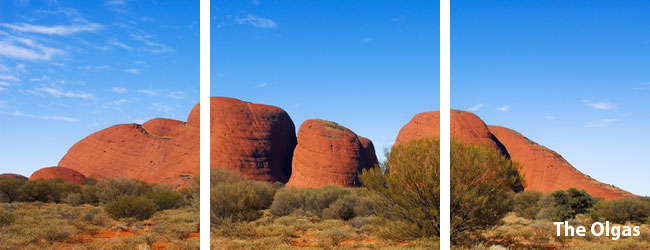Campervan in The Olgas - Outback Guide
Officially known as Kata Tjuta or Mount Olga, The Olgas have become one of the Northern Territory's most recognisable attractions. This group of large domed rock formations is located approximately 365 kilometres south-west of Alice Springs and are one of the two major landmarks in the Uluru-Kata Tjuta National Park.
There are a total of 36 domes that are all composed of conglomerate, a sedimentary rock consisting of cobbles and boulders of varying rock types including granite and basalt, cemented by a matrix of sandstone. The tallest of these is Mt Olga, which stands at an impressive 546 metres high.
The name has been deservingly given to The Olgas as Kata Tjuta actually means "many heads" in traditional Aboriginal language. It is this connection with the Aboriginal history and culture that makes The Olgas such an unforgettable place to visit in the Australian outback.

Travel Distances
The Olgas are located approximately 365 kilometres south-west of Alice Springs. They are positioned just 53 kilometres from Ayers Rock and 51 kilometres from the Ayers Rock Resort.
The drive to Kata Tjuta from Darwin is a long one and tourists often mistake these distances and are met with a rude shock when they attempt them. The National Park is located just less than 2000 kilometres south of Darwin, which would take almost 24 hours to drive. This should not be attempted in one go!
Airports and Campervan Depots
There are two main airports tourists use to fly into the Northern Territory. Alice Springs Airport and Darwin International Airport are both located near campervan depots and are ideal places to begin your campervan holiday in Kata Tjuta.
Campervan travellers can choose to either pick up their vehicle from Alice Springs or Darwin. A one-way rental is a popular option for those wishing to simply travel between the two and not backtrack on where they have already driven.
Park Use Fees
There is an entrance fee that applies to Uluru-Kata Tjuta National Park. The fee is $25 per adult, with children under 16, free. This fare allows multiple entry into the park for 3 consecutive days.
What to See and Do
The Yulara Visitors Centre is a great place to start your exploration of Kata Tjuta. The centre provides information on local history, geology, flora, fauna and culture. It also sells souvenirs and educational gifts.
There are 2 walks that visitors can take to experience the beauty and wonder of The Olgas. The Valley of the Winds Walk spans 7 kilometres and circles several of the Olgas. The best time to do this walk is in the early hours of the morning, as if the temperature soars too high, the track will be closed.
The Olga Gorge Walk is a great alternative for those wishing to take a shorter walk. This track will take you right into the gorge and is a must if you have an hour to spare.
Climate and Weather
Kata Tjuta is situated almost directly in the centre of Australia, which is of course semi-arid desert. Because of this, most people usually assume that climate is hot during the day and cold at night, yet this is not always the case. Very little rain falls in these parts, so you can expect the environment to be dry almost all year round.
Best Time to Visit
Kata Tjuta is best avoided during the summer months as this is when the temperatures tend to soar. If you are intent on completing the walks around The Olgas, the best time to attempt them is in the very early hours of the morning, because once it reaches around 11am, the heat becomes almost too unbearable to walk in.
What to wear?
As for all locations in the Australian outback, the best type of clothing to wear is loose-fitting and covered. The sun in the outback is incredibly harsh, making long-sleeved shirts and plenty of sunscreen a must.
It is also important to wear sturdy, covered shoes, as the walks can be quite challenging and you will need support for your feet and ankles.
Temperatures tend to drop at night, so be sure to bring along some warm clothes to avoid the chill.
Wildlife
This part of the outback is a haven for a unique collection of native birds, reptiles, and mammals, all of which have adapted to the harsh environmental conditions of central Australia.
Some of the most common birds you will spot here include galahs, painted firetails and wedge-tailed eagles. These are accompanied by reptiles like the Thorny Devil, nocturnal desert skink and the mulga snake.
The outback's most popular mammals include the spinifex hopping mouse, the rufous hare wallaby, mulgara, the brush-tailed possum, Red-Kangaroo and the dingo.
Some wildlife in the outback can be dangerous so visitors should never attempt to interact or feed wild animals here.
Driving Restrictions and Tips
The roads within Uluru-Kata Tjuta National Park are all sealed and suitable for campervans to travel on them. As with driving anywhere in the outback, it is important to drive carefully at night and always keep an eye out for wildlife.
As the outback is so dry, there is a lot of dust and this tends to cloud people's vision while driving. Therefore, if you are travelling in a group of behind someone, it is essential that you keep a safe distance to avoid this.
Nearby Attractions
The Olgas are often overlooked by tourists in favour of the more famous, Uluru, or Ayers Rock. Uluru has been fascinating and inspiring tourists from across the world for years and is essentially what draws people to the Great Australian outback. The rock is particularly magnificent at sunrise and sunset and should not be missed while in this part of the country.
Mount Conner is also located within the Kata Tjuta National Park and is definitely worth the visit. Often mistaken for its bigger sister, Uluru, Mount Conner is actually 3 times larger than Uluru and tours of it can be arranged at the nearby Curtin Springs Station.
What to bring?
It is absolutely necessary to bring plenty of water to Uluru-Kata Tjuta National Park, regardless of the length of your stay. Ensuring you always have fuel in your petrol tank is also important as distances between roadhouses can be vast.
Appropriate clothing, sun protection, insect repellant and shoes are also vital, because of the changing weather conditions. This is the outback, so remember it gets extremely hot!
It is also a good idea to bring a suitable amount of food. The shops within the park are quite expensive, so it works out a lot cheaper to bring your own in.
Another must-have for your campervan adventure in The Olgas is your camera. The landscapes here are unlike anywhere else in the world so you will want to remember your memories of this place.
Places to Stay
Unfortunately there is no accommodation within the park and camping is not permitted. However, there is a campground available in Yulara, which is just outside the park's boundary. The Ayers Rock Campground offers a range of services and facilities that almost make you completely forget you are staying in the middle of the outback. Park your campervan under the shade of native desert oaks and enjoy the lovely grass sites and you soak up the pleasant cultural ambience of this one-of-a-kind resort.
Shops/Supermarkets
The only shop you will find at or near Kata Tjuta is the Cultural Centre, which sells souvenirs and authentic art. Food and drinks can be purchased in Yulara but keep in mind that it is very expensive.
Roadhouses/Petrol Stations
Mt Ebenezer Roadhouse is one of the Northern Territory's best roadhouses and is still owned and operated by Aboriginal people. The roadhouse boasts an impressive art gallery, with friendly service and a laid-back atmosphere.
Petrol in the outback also tends to be more expensive in the outback. For the latest information on Australian fuel prices visit Motormouth.
For a more comprehensive list of roadhouses in the Northern Territory and beyond, visit our 101 Outback Roadhouses in Australia.

